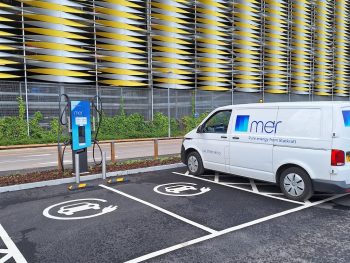Comment: Advancing decarbonisation strategies with fleet depot charging
With a heightened focus on environmental goals, British businesses are under intense pressure to decarbonise operations. Giles Benbow, Mer’s head of commercial development & support for business charging, examines how depot charging for EV fleets helps balance environmental responsibilities with commercial targets.

Giles Benbow, Mer’s head of commercial development & support for business charging
For several years, businesses across the UK have stepped up to stringent decarbonisation targets in their efforts to align with national climate goals and global sustainability. Since the 2050 net-zero target was set in the Climate Change Act of 2008, the UK’s annual carbon emissions have dropped from 544.93 to 303.15 million tonnes, more than halving the 1971 high of 660.39 million tonnes.
Major breakthroughs have largely been achieved through legislation. While regulations force companies to change using the ‘stick’ in the old analogy, businesses also need a ‘carrot’ in the shape of sound commercial and economic encouragement. It simply makes sense for decarbonisation programmes to include energy strategies that balance commercial ambition with environmental responsibilities.
Turning strategy into action
In order to meet decarbonisation objectives, businesses need to translate science-based target initiatives (SBTi) into practical, operational changes. Many have introduced measures to reduce their Scope 1 and 2 greenhouse gas (GHG) emissions and are working with suppliers to reduce Scope 3. They’re implementing strategies such as reducing business travel, using more renewable electricity and switching company fleets to EVs to meet the zero-emissions vehicle (ZEV) mandate.
These aren’t just environmental gestures; they are essential business practices.
For many businesses, strategic fleet electrification is a key tool in their decarbonisation journey, with the EV charging infrastructure playing a central role. Replacing fossil-fuel vehicles with electric fleets obviously reduces carbon output, but it also presents a significant opportunity to reduce costs, use electricity more effectively and integrate more renewable electricity into a business’s operations.
Depot charging achieves all this and more
Environmentally focused legislation, such as the ZEV mandate, makes transitioning to EV fleets inevitable. The challenge is to make it economically viable. After all, economic decisions are the primary motivator for businesses, not environmental sentiment.

No two depots are the same as the physical aspects and constraints differ from site to site
Intelligently thought-through depot charging makes it possible to deliver on decarbonisation commitments while presenting a lower total cost of operation (TCO) for the entire EV fleet.
The ultimate goal is to reduce TCO to a point where electric vehicles become the most financially attractive option for businesses. There’s still some way to go, given the high cost of commercial EVs, but these are coming down as technology advances and manufacturers react to competitive pressures.
Depot charging involves much more than charging stations; it includes the entire ecosystem that supports the use and efficiency of the EV fleet. This takes in everything from design and installation, to sourcing electricity, smart grid management, ongoing maintenance, cost control and maximising charger usage. It’s a holistic approach that takes the entire operation into consideration and calls for an EV infrastructure partner that can add value at every stage of the transition to reduce the TCO and advance decarbonisation.
The economics of depot charging
There’s no doubt that designing and optimising depot charging infrastructure is a complex business. No two depots are the same as the physical aspects and constraints differ from site to site. The same is true of the specific requirements of each fleet operator, but what they do have in common is a need to reduce vehicle operating costs.
Working with a proven EV charging partner for depot charging can help reduce TCO. The goal is for it to become low enough to make EV adoption a ‘no-brainer’ for the business. As the EV market has matured for both vehicle manufacturers and charge point operators, charging partners have access to range of tools and strategic approaches that significantly reduce the cost of owning and operating an EV fleet.
For example, established EV charging partners can help fleet operators optimise energy costs by scheduling charging during low electricity pricing periods, aggregated energy procurement, and even employing competitive hedging strategies to optimise energy market opportunities.
Today’s fleet and depot charging infrastructure specialists offer much more than hardware installation, however. They effectively act as decarbonisation partners, providing consultancy in depot charging infrastructure design and flexible funding models. Forward-thinking charging infrastructure providers are also able to develop integrated solutions that combine private depot charging with access to public charging networks when a vehicle is on the road, and importantly flexible access to charging if the infrastructure is unexpectedly unavailable.
Decarbonisation partners
As the EV fleet market matures, businesses are increasingly turning to their charging infrastructure partners for guidance around innovative funding approaches. Adopting models such as ‘infrastructure-as-a-service’ and ‘charging-as-a-service’ along with bundled energy and infrastructure packages can transform a significant capital expenditure into predictable operational costs.
At Mer, our consultative depot charging design sees EV infrastructure experts working closely with businesses to design charging solutions that match their specific operational requirements. They take into consideration the vehicle types, workloads, charging schedules and energy consumption patterns.
Integrating telematics and route planning with EV charging schedules and data from charging assets in a single integrated fleet management dashboard enables energy management and, through charge scheduling, minimises vehicle downtime, another economic imperative.
We will see more of these kinds of innovations as EV charging continues to evolve, and people become more attuned to the benefits of depot charging. Even more possibilities will emerge as the primary concerns of the fleet manager and the EV charging partner align. Both regard the operation of the charging infrastructure as part of the broader, decarbonisation-focused energy strategy of the business – including the sourcing of renewable energy in the case of Statkraft-backed Mer.
To explore passive income from EV charging, download Mer’s guide to EV charging hubs.
Depot chargingFleet electrificationMer














Leave a comment